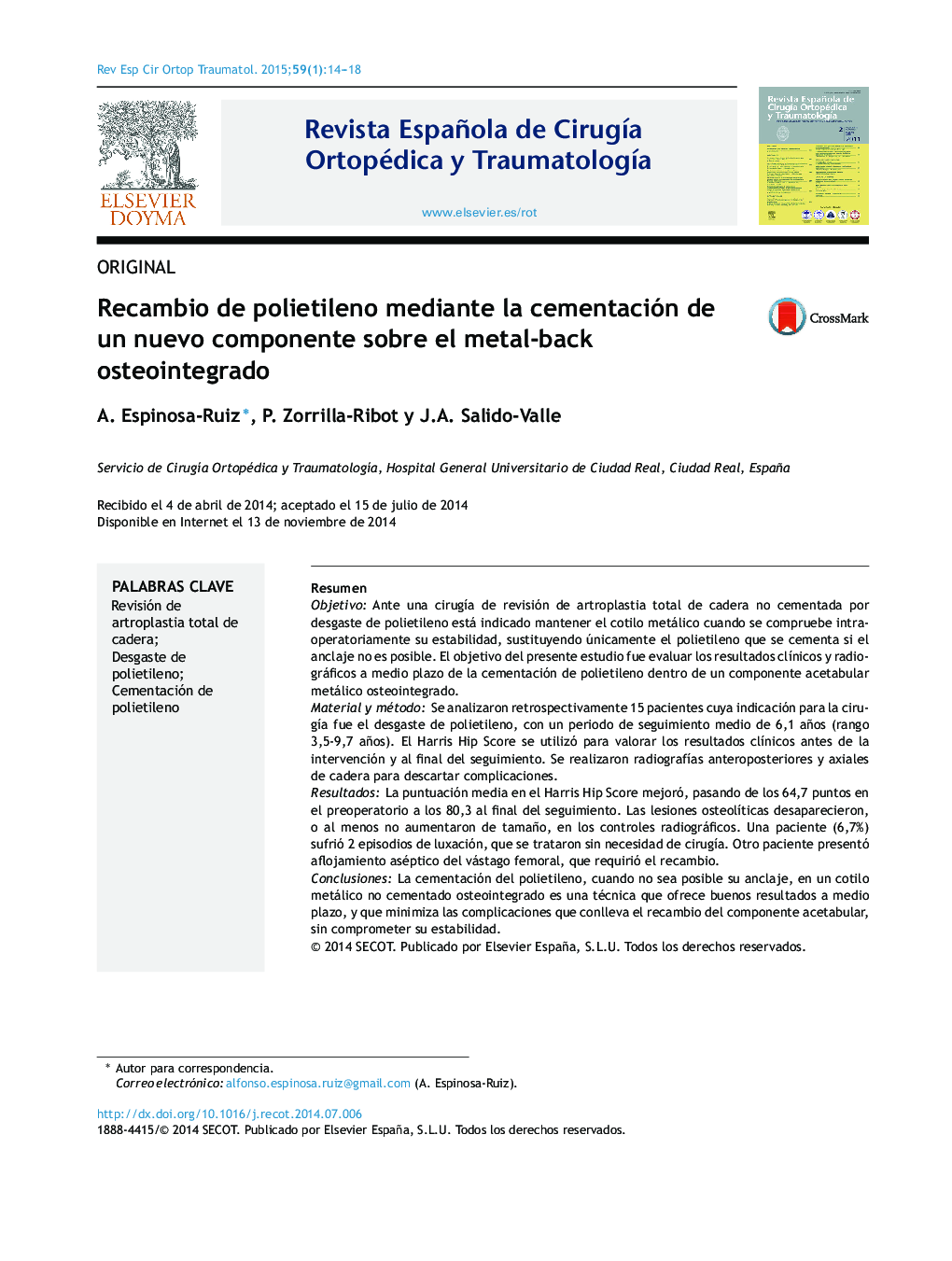| Article ID | Journal | Published Year | Pages | File Type |
|---|---|---|---|---|
| 4086326 | Revista Española de Cirugía Ortopédica y Traumatología | 2015 | 5 Pages |
ResumenObjetivoAnte una cirugía de revisión de artroplastia total de cadera no cementada por desgaste de polietileno está indicado mantener el cotilo metálico cuando se compruebe intraoperatoriamente su estabilidad, sustituyendo únicamente el polietileno que se cementa si el anclaje no es posible. El objetivo del presente estudio fue evaluar los resultados clínicos y radiográficos a medio plazo de la cementación de polietileno dentro de un componente acetabular metálico osteointegrado.Material y métodoSe analizaron retrospectivamente 15 pacientes cuya indicación para la cirugía fue el desgaste de polietileno, con un periodo de seguimiento medio de 6,1 años (rango 3,5-9,7 años). El Harris Hip Score se utilizó para valorar los resultados clínicos antes de la intervención y al final del seguimiento. Se realizaron radiografías anteroposteriores y axiales de cadera para descartar complicaciones.ResultadosLa puntuación media en el Harris Hip Score mejoró, pasando de los 64,7 puntos en el preoperatorio a los 80,3 al final del seguimiento. Las lesiones osteolíticas desaparecieron, o al menos no aumentaron de tamaño, en los controles radiográficos. Una paciente (6,7%) sufrió 2 episodios de luxación, que se trataron sin necesidad de cirugía. Otro paciente presentó aflojamiento aséptico del vástago femoral, que requirió el recambio.ConclusionesLa cementación del polietileno, cuando no sea posible su anclaje, en un cotilo metálico no cementado osteointegrado es una técnica que ofrece buenos resultados a medio plazo, y que minimiza las complicaciones que conlleva el recambio del componente acetabular, sin comprometer su estabilidad.
ObjectiveIn uncemented revision total hip replacement due to polyethylene wear, the metal cup needs to be maintained when its stability is checked during surgery, only replacing the polyethylene that is cemented if anchoring is not possible. The aim of the present study was to evaluate the medium-term clinical and radiological results of a polyethylene liner cemented into an osseointegrated acetabular shell component.Material and methodA retrospective analysis was performed on 15 patients in whom the surgical indication was polyethylene wear, with a mean follow-up of 6.1 years (range 3.5-9.7 years). The Harris Hip Score was used to assess the clinical results before surgery and at the end of follow-up. Anteroposterior and axial X-rays of the hip were taken to rule out complications.ResultsThe mean Harris Hip Score improved, increasing from 64.7points before the surgery to 80.3 at the end of follow-up. The osteolytic lesions disappeared, or at least the size did not increase, in the follow-up X-rays. One patient (6.7%) suffered 2 dislocation episodes that were treated without the need for surgery. Another patient presented with aseptic loosening of the femoral stem that required a replacement.ConclusionsCementing the polyethylene liner, when anchoring is not possible, in an uncemented osseointegrated metal shell is a technique that offers good results in the medium term, and which may minimise the complications that may occur with the replacement of the shell component, without compromising its stability.
